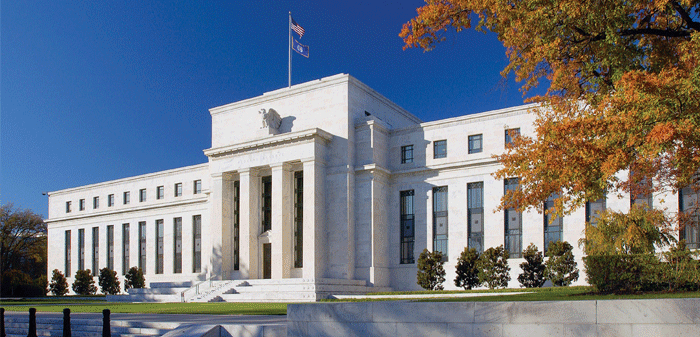

As the U.S. central bank, the Federal Reserve carries out a number of functions that affect the nation's economic well-being. These responsibilities fall into four broad categories. Through monetary policy, which influences the availability of money and credit, the Fed plays a major role in keeping inflation in check while promoting economic growth. By supervising and regulating commercial banks, the Fed fosters the safety and soundness of the U.S. banking and financial systems. The central bank also has broad responsibility for maintaining financial stability and containing systemic risk in financial markets. And by providing check-clearing and other financial services to depository institutions and the federal government, the Fed helps make commercial transactions more efficient.
Public policy—particularly fiscal policy and monetary policy—has a major influence on a country's economic performance.
The legislative and executive branches of the U.S. government determine fiscal policy, chiefly through decisions about taxation and spending. The Federal Reserve carries out monetary policy.
The nation's economic policy objectives are to protect the purchasing power of the U.S. dollar, encourage conditions that sustain economic growth and a high level of employment, and foster a reasonable balance in transactions with other nations over the long run. The Federal Reserve contributes to these objectives through its monetary policy actions, which affect the availability and cost of money and credit.
The Federal Reserve's monetary policy goals, as prescribed by Congress, are to promote maximum employment and price stability. These two goals are often referred to as the Fed's dual mandate.
The Fed responds to changing economic conditions, basing its policy decisions on current economic and financial information. For example, the FOMC's policy actions are influenced at least in part by the economic analysis that staff economists and analysts at the Reserve Banks and the Board of Governors provide. Each component of the Fed—the Board of Governors, the Reserve Banks, and the FOMC—plays some role in formulating and carrying out monetary policy.

Tools of Monetary Policy
To foster economic growth while maintaining stable prices, the Federal Reserve must balance the flow of money and credit with the needs of the economy. The Board of Governors, the Reserve Banks, and the FOMC achieve this balance by influencing the levels of financial institutions' reserves, which in turn affect institutions' ability to make loans or purchase investments. These reserves, required by law of all U.S. depository institutions, must be equal to specified percentages of the institutions' deposits and can be held either as cash on hand or as account balances at Reserve Banks.
The Federal Reserve in recent decades has taken steps to increase the transparency of its monetary policy decisions and objectives. Since issuing its first post-meeting policy statement in 1994, the Federal Open Market Committee (FOMC) has gradually provided more information about its policy decisions and intentions. These changes reflect not only the Fed's role as a public institution but also a growing recognition–backed by empirical studies–that clear communication enhances the effectiveness of monetary policy.
The Fed's efforts to support the economic recovery from the 2007–09 recession included expanding the role of communication even further. With the federal funds rate near zero, the FOMC began to rely on forward guidance–communications about the expected path of policy–to ease economic and financial conditions more. As Atlanta Fed President Dennis Lockhart explained in a 2014 speech, "modern monetary policy is aimed at influencing economic outcomes through the 'expectations channel.' Expectations drive decisions by consumers, households, businesses, and investors throughout the economy. These decisions, taken together, have a big influence on the trajectory of the economy."
Traditionally, the Fed has used three main policy tools for influencing reserves: open market operations, the discount rate, and reserve requirements.
Open market operations. The most flexible and frequently used of the Fed's monetary policy tools, open market operations refer to the purchase and sale of government securities in the open market. The FOMC directs the Fed's open market operations and the New York Fed conducts them through its trading desk.
The Federal Reserve uses open market operations to adjust the supply of reserve balances to keep the federal funds rate—the interest rate at which depository institutions lend reserve balances to other depository institutions overnight—at around the target that the FOMC establishes.
When the Fed buys government securities, it credits the reserve accounts of the depository institutions handling the transactions. These larger reserve accounts give the banks more money for lending and investing in the economy.
Alternately, the Fed raises the federal funds rate by selling securities, which tightens money and credit flows. These sales restrain the growth in banks' reserve balances and restrict their lending and investing activities.
The discount rate. Depository institutions sometimes borrow money from Reserve Banks to cover temporary deposit drains. A change in the discount rate—the interest rate charged on these short-term, "discount window" loans—can either inhibit or encourage financial institutions to lend and invest by making it more or less expensive for them to obtain funds. Although the discount rate may have little direct effect on market conditions, a change in the discount rate can be an important signal of the Fed's policy direction.
Reserve requirements. Within legal limits, the Board of Governors can change the percentage of deposits that depository institutions must set aside as reserves. The Federal Reserve changes reserve requirements much less often than it does the discount rate because such changes have more of a far-reaching impact on the financial industry by affecting banks' ability to make loans and invest. A higher level of reserves pushes the federal funds rate lower. Alternately, fewer available reserves cause an increase in the federal funds rate.
The Fed gained an additional monetary policy tool in 2008, when Congress granted the Fed authority to pay interest on depository institutions' reserve balances. Essentially, the interest rate paid on reserves acts as a floor beneath the federal funds rate because banks are not willing to loan to each other at a rate that is significantly lower than what they can earn risk-free on their reserves with the Fed.

Commercial banks are governed by a variety of regulations intended to ensure that they serve their depositors and communities well and follow sound banking principles.
The Federal Reserve and other banking regulatory agencies share responsibility for writing these regulations and for examining banks to determine their compliance. The Board of Governors carries out the Federal Reserve's regulatory responsibilities by writing rules that either restrict or allow a bank's activities. The Board often adopts these regulations in response to federal legislation.
The Fed supervises companies that own banks and thrifts as well as state-chartered banks that are members of the Federal Reserve System. The Fed also oversees certain U.S. activities of foreign banks and companies that play an important role in the financial system.
The Reserve Banks carry out the Fed's supervisory duties by conducting onsite examinations regularly and by monitoring the reports that banks file.
The Fed also examines banks with $10 billion in assets or less to ensure that they do not engage in discriminatory practices when making lending decisions.
Bank and financial holding companies and certain banks that wish to acquire or merge with other banks must obtain Federal Reserve approval. Reserve Bank staff analyze the banks and financial markets that will be affected by a proposed merger or acquisition, taking into account the convenience and needs of the community that the institutions serve as well as the financial and managerial resources of the existing and proposed institutions. The Board of Governors approves or disapproves merger and acquisition applications based on Reserve Banks' findings and recommendations.
The Fed gained additional supervisory responsibilities under the Dodd—Frank Wall Street Reform and Consumer Protection Act, including the authority to monitor large or complex institutions that could threaten the stability of the U.S. economy and financial system. The landmark legislation also created a Financial Stability Oversight Council to identify and address emerging risks to the financial system. The chair of the Board of Governors serves on the council.
In addition, Reserve Banks monitor commercial banks' compliance with consumer protection laws relating to credit, such as the Truth in Lending Act. Reserve Bank specialists help banks interpret technical requirements of the laws. They also provide information and assistance to consumers who have questions or complaints regarding commercial banks' services.
Discount Window Loans
Reserve Banks also help maintain a sound banking system by acting as the lender of last resort for depository institutions. Institutions that find themselves temporarily short of reserves because of unexpected credit demands, deposit drains, seasonal economic factors, or severely impaired financial markets may be eligible to borrow from a Reserve Bank. By serving as the lender of last resort, the Fed supports the stability of individual depository institutions and the banking and financial system as a whole. Traditionally, financial institutions seek funds first from reasonably available alternative sources and draw on the discount window only in exceptional circumstances. The Fed encourages banks to seek funding first from other sources by lending at a rate that is higher than the short-term rates that would ordinarily prevail in the market.
Generally, Reserve Banks make discount window loans for a day or two to help the borrowers adjust their reserve position. Discount window credit is subject to governing statutes and is administered according to Federal Reserve policy guidelines by lending officers at the Reserve Banks.
As part of the nation's central bank, Reserve Banks are actively involved in the nation's payment system to help it operate as efficiently and safely as possible. Unlike private providers of payment services, Federal Reserve Banks do not offer these services to make a profit—their service fees must closely match and not exceed their costs.
Since the passage of the Depository Institutions Deregulation and Monetary Control Act of 1980, Reserve Banks' financial services have been available not just to banks that are members of the Federal Reserve System but also to nonmember commercial banks, savings and loan associations, credit unions, and mutual savings banks.
In some ways Federal Reserve Banks' services to depository institutions are similar to depository institutions' services to their customers—transferring funds, providing cash, and accepting and safeguarding deposits.

Payment System Services
Cash services. Although checks and electronic payments account for most of the dollar volume of spending, cash is still an important medium of exchange.
The Federal Reserve is responsible for ensuring that enough cash is circulating to meet public demand. The U.S. Bureau of Printing and Engraving produces Federal Reserve notes and ships them to the Federal Reserve Banks. The U.S. Mint does the same for coins. The Federal Reserve stores the cash until depository institutions need it. Depository institutions, of course, furnish cash to businesses and the public.
When depository institutions have excess cash on hand, they may return the excess to the Reserve Banks. There, cash processors verify the amount, destroy worn-out notes, and remove counterfeits and send them to the Secret Service. The Reserve Banks weigh bags of coins to verify their amounts, but unlike paper currency, they do not check them for wear and tear. When depository institutions order cash, the Reserve Banks fill the orders from their stocks of new and used coins and notes.
Check collection. Check usage has steadily declined since peaking in the mid-1990s, while electronic payment methods have gained popularity. The Fed processes about one-third of U.S. paper checks. Commercial banks may also clear checks through clearinghouse associations or through agreements with other banks. The Check Clearing for the 21st Century Act, enacted in 2004, allows banks to substitute paper checks with electronic images of the check, which speeds the clearing process. Today, almost 99 percent of checks are processed this way. The Atlanta Fed processes electronic and paper checks for the Federal Reserve System.
Electronic payments and funds transfers. Reserve Banks and one other private-sector operator provide nationwide processing of automated clearinghouse (ACH) electronic payments. The Fed processes about three-fourths of ACH payments in the United States. ACH payments, which are cheaper to process than checks, are used for direct deposit of payroll and corporate payments to vendors. Consumers use ACH transfers to pay insurance premiums, mortgages, loans, and other bills. One-time payments made over the Internet or by telephone as well as converted paper check payments are additional examples of ACH transactions.
Reserve Banks also provide an electronic funds transfer (EFT) system—Fedwire—that depository institutions can use to make large-value, time-critical payments for interbank purchases, sales of securities, disbursing or repaying loans, or settling real estate transactions.
Safekeeping and Transfer of Securities
Depository institutions may request a Reserve Bank to hold securities either for safekeeping or as collateral for loans from the Federal Reserve. These securities are held in the form of electronic records in custody accounts. Reserve Banks also perform such services as transferring securities between accounts and processing associated payments.
Services to the U.S. Treasury
Reserve Banks provide a number of banking and financial services to the U.S. Treasury, including two major services.
The Treasury's checking account. Incoming federal government revenues are credited to the U.S. Treasury's accounts at Reserve Banks. Most of these revenues come from transfers of funds from depository institutions in which the Treasury initially deposited its receipts from taxes and the sale of securities. The transfers are accomplished by debiting the depository institutions' reserve balances with the Federal Reserve and crediting the Treasury's account with the Fed. Reserve Banks disburse money from the Treasury's account through EFT or ACH payments or, to a limited extent, by check.
The Treasury's fiscal agent. When its current expenses run ahead of its current cash resources, the Treasury borrows, mostly by auctioning government securities to investors. The auctions are held by the Federal Reserve Banks, acting as the Treasury's fiscal (financial) agents. The Fed also inscribes and delivers U.S. savings bonds sold through depository institutions and other issuing agents.